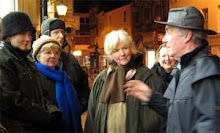
Two sarsen stones thought to mark the final resting place of Walter Leader. (Image credit Bozzer)
On the A361 between Beckhampton and Devizes stand two sarsen stones. They are said to mark the final resting place of Walter Leader, the unfortunate character who, in 1811 was convicted and later hanged for his alleged involvement in the murder of Henry Castles, the driver of the ill fated Royal Mail coach which was attacked and robbed by a gang of highwaymen, possibly the notorious 'Cherhill Gang'. When the gang had completed their pernicious deed, they made off in the direction of Beckhampton, taking with them the loot and leaving Henry Castles fatally wounded.
As they fled the scene they came across the decidedly worse for drink, Walter Leader. Seizing the opportunity to frame him for their dastardly deeds, they attacked him rendering him unconscious. Quickly returning to the seen of the crime, they dumped the incapacitated Walter next to Henry Castles. Great care was then taken to incriminate him by placing a pistol in his hand. Walter was later discovered in this rather compromising situation and was promptly arrested. At his trial, the evidence against him seemed insurmountable and Walter was sentence to hang for the murder of Henry Castles, probably at nearby Cherhill or Morgan’s Hill both infamous for public hangings and their gibbets.
It is said, that as Walter was being lead to the gallows he saw a horseman approaching in the distance and pleaded with his executioners to wait in case he may be pardoned. They didn’t, and Walter Leader was duly dispatched. Minutes after his death the horseman arrived and with much haste demanded Leaders reprieve. As it turned out, one of the gang members had got in to a quarrel with the others and decided to turn ‘King's Evidence’ at Bath. A horseman had been immediately dispatched, with orders to relinquishing Walter Leader from his crime, unfortunately for Walter the news arrived a tad too late.
His body was duly cut down and carried by cart to where the A361 cuts through the landscape. He was buried facedown, with his head to the west on a spot marked by two sarsen stones. His grave lies where the old Roman road crosses the A361 a mile west of Beckhampton.
To this day, people still report seeing the ghostly figure of a man wearing a black cloak and a tricor hat and wandering the adjacent byways. A similar figure has been seen close to where the gibbet once stood at Cherhill. Could these apparitions be that of Walter Leader I wonder.
Wiltshire's Highwaymen
Following the end of the Civil Wars, the emergence of ‘Highwaymen’ came into being. Many of them were discharged soldiers, who were facing poverty due to lack of work. In desperation, some turned to crime. Already proficient horsemen and well adept in the use of firearms, these rouges preyed on the rich pickings available from the many coaches that passed through Devizes, Chippenham and Beckhampton on their way to London or Bath.
The thickly wooded Wiltshire countryside proved ideal cover for ambushing unwary travellers. During the 18th century it became popular for the London elite to spend their vacations in fashionable Bath where they would ‘take the waters‘ in the Roman baths. Highwaymen wised up to this annual pilgrimage and took advantage of the affluent.
Highwaymen in general treated their victims with some courtesy, in fact they became known as “Gentlemen of the Road”. Violence was rare unless you were foolish enough to provoke them. The best course of action would be to hand over your lolly as quickly as you could, then just watch your valuables disappear into the woodland. It is a sad reflection on society today, that such courteous traditions have been lost. Nowadays an innocent remark or an innocuous look can get you into serious trouble by those using sludge for brains.
One of the most notorious groups of highwaymen in Wiltshire were called the ’Cherhill Gang’. These individuals operated on the tracks between Marlborough, Calne, Beckhampton and Devizes. It is a well known fact, that to avoid identification and to instill even more fear into their victims (if that were at all possible) the gang would strip naked and paint themselves white before attacking. I can only think that they thought the eyes of their victims would be preoccupied elsewhere other than their faces, ensuring some uncertainty when asked who had attacked them. A painting of the Cherhill Gang hangs in the Black Horse pub, between Beckhampton and Calne on the A4, the old London road.
Highwaymen became less common as the early part of the 19th century dawned. There are several reasons for their decline. Woodland was being cleared to allow for agriculture, therefore diminishing much needed cover for ambushing; the police presence was growing, the byways were now frequently patrolled by armed officers; the Justice offices refused to grant licences to innkeepers who they believed were harbouring criminals and the increased availability of honest work, a route taken by many highwaymen to avoid the gallows.






No comments:
Post a Comment